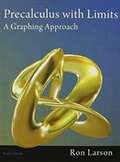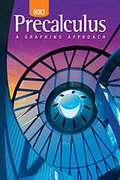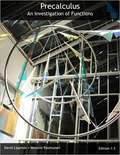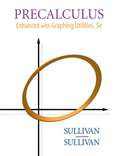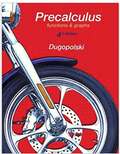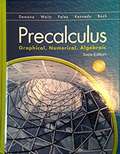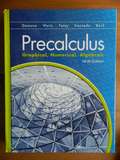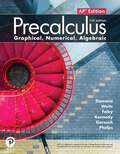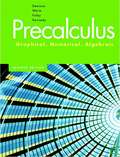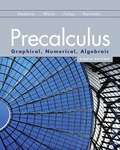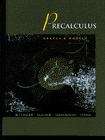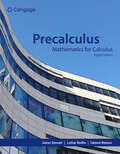- Table View
- List View
Precalculus with Limits: A Graphing Approach (AP Version, 4th Edition)
by Ron LarsonPrecalculus with Limits: A Graphing Approach focuses on making mathematics accessible, supporting student success, and offering instructors flexibility in how the course can be taught.
Precalculus with Limits: A Graphing Approach (Math Detective Pilot Test)
by Ron Larson David C. FalvoNIMAC-sourced textbook
Precalculus: A Graphing Approach
by Thomas W. Hungerford Betty Mayberry Irene Sam JovellThis book provides the mathematical background needed for calculus. The text integrates graphing technology into the course without losing the underlying mathematics, which is the crucial issue. Mathematics is presented in an informal manner that stresses meaningful motivation, careful explanations, and numerous examples, with an ongoing focus on real-world problem solving.
Precalculus: A Graphing Approach
by Holt Winston RinehartThis book provides the mathematical background needed for calculus by presenting Mathematics in an informal manner that stresses meaningful motivation, careful explanations, and numerous examples, with an ongoing focus on real-world problem solving.
Precalculus: A Problem Solving Approach - Student Workbook
by Kevin Moore Marilyn Carlson Michael Oehrtman Alan O'BryanThe materials in this workbook are designed with student learning and success in mind and are based on decades of research on student learning. In addition to becoming more confident in mathematical abilities, the reasoning patterns, problem solving abilities and content knowledge that the student acquire will make more advanced courses in mathematics, the sciences, engineering, nursing, and business more accessible. The investigations and text will help see a purpose for learning and understanding the ideas of precalculus, while also helping the student acquire critical knowledge and ways of thinking that the student will need for learning calculus.
Precalculus: An Investigation of Functions
by David Lippman Melonie RasmussenThis book is a free, open textbook covering a two-quarter pre-calculus sequence including trigonometry. The first portion of the book is an investigation of functions, exploring the graphical behavior of, interpretation of, and solutions to problems involving linear, polynomial, rational, exponential, and logarithmic functions. An emphasis is placed on modeling and interpretation, as well as the important characteristics needed in calculus. The second portion of the book introduces trigonometry. Trig is introduced through an integrated circle/triangle approach. Identities are introduced in the first chapter, and revisited throughout. Likewise, solving is introduced in the second chapter and revisted more extensively in the third chapter. As with the first part of the book, an emphasis is placed on motivating the concepts and on modeling and interpretation. In addition to the paper homework sets, algorithmically generated online homework is available as part of a complete course shell package, which also includes a sample syllabus, teacher notes with lecture examples, sample quizzes and exams, printable classwork sheets and handouts, and chapter review problems.
Precalculus: An Investigation of Functions Edition 1.5
by David Lippman Melonie RasmussenPrecalculus: An Investigation of Functions is a free, open textbook covering a two-quarter pre-calculus sequence including trigonometry. The first portion of the book is an investigation of functions, exploring the graphical behavior of, interpretation of, and solutions to problems involving linear, polynomial, rational, exponential, and logarithmic functions. The second portion of the book introduces trigonometry.
Precalculus: Enhanced with Graphing Utilities (5th Edition)
by Michael SullivanThese authors understand what it takes to be successful in mathematics, the skills that students bring to this course, and the way that technology can be used to enhance learning without sacrificing math skills. As a result, they have created a textbook with an overall learning system involving preparation, practice, and review to help students get the most out of the time they put into studying. In sum, Sullivan and Sullivan's Precalculus:Enhanced with Graphing Utilities gives students a model for success in mathematics.
Precalculus: Functions and Graphs
by Mark DugopolskiThe Right Tools to Drive Your Success <p> Dugopolski’s Precalculus: Functions and Graphs, Fourth Edition gives students the essential strategies they need to make the transition to calculus. <p><p>Along the way, students see how the algebra connects to their future calculus courses, with tools like Foreshadowing Calculus and Concepts of Calculus. The author’s emphasis on problem solving and critical thinking is enhanced by a new MyMathLab course, where students will find new Video Assessment questions tied to section lecture videos; Getting Ready material to help learn necessary prerequisite skills; Guided Visualizations, and more!
Precalculus: Graphical, Numerical, Algebraic
by Bert K. Waits Gregory D. Foley Daniel Kennedy Franklin D. DemanaHigh School Math Textbook
Precalculus: Graphical, Numerical, Algebraic
by Bert K. Waits Gregory D. Foley Franklin D. DemanaNIMAC-sourced textbook
Precalculus: Graphical, Numerical, Algebraic
by Daniel Kennedy Franklin Demana Bert Waits Gregory Foley David BockPrecalculus: Graphical, Numerical, Algebraic This textbook is written to address current and emerging state curriculum standards. In particular, we embrace NCTM's Focus in High School Mathematics: Reasoning and Sense Making and its emphasis on the importance of helping students make sense of and reason using mathematics. The NCTM's Principles and Standards for School Mathematics identified five "Process Standards" that should be fundamental in mathematics education. The first of these standards was Problem Solving. Since then, the emphasis on problem solving has continued to grow, to the point that it is now integral to the instructional process in many mathematics classrooms. When the Common Core State Standards in Mathematics detailed eight "Standards for Mathematical Practice" that should be fundamental in mathematics education, again the first of these addressed problem solving. Individual states have also released their own standards over the years, and problem solving is invariably front and center as a fundamental objective. Problem solving, reasoning, sense making, and the related processes and practices of mathematics are central to the approach we use in Precalculus: Graphical, Numerical, Algebraic.
Precalculus: Graphical, Numerical, Algebraic (7th Edition)
by Bert K. Waits Gregory D. Foley Daniel Kennedy Franklin D. DemanaIn this new edition of Precalculus,Seventh Edition, the authors encourage graphical, numerical, and algebraic modeling of functions as well as a focus on problem solving, conceptual understanding, and facility with technology. They responded to many helpful suggestions provided by students and teachers in order to create a book that is designed for instructors and written for students. As a result, we believe that the changes made in this edition make this the most effective precalculus text available today.
Precalculus: Graphical, Numerical, Algebraic (7th edition)
by Bert K. Waits Gregory D. Foley Daniel Kennedy Franklin D. DemanaIn this Seventh Edition of Precalculus, a book that is designed for instructors and written for students, the authors encourage graphical, numerical, and algebraic modeling of functions as well as a focus on problem solving, conceptual understanding, and facility with technology.
Precalculus: Graphical, Numerical, Algebraic (Eighth Edition)
by Franklin D. DemanaThis textbook has faithfully incorporated not only the teaching strategies that have made Calculus: Graphical, Numerical, Algebraic so popular, but also some of the strategies from the popular Prentice Hall high school algebra series, and thus has produced a seamless pedagogical transition from prealgebra through calculus for students.
Precalculus: Graphical, Numerical, Algebraic (Sixth Edition)
by Bert K. Waits Gregory D. Foley Daniel Kennedy Franklin DemanaThis textbook helps students truly understand the fundamental concepts of algebra, trigonometry, and analytic geometry, foreshadows important ideas of calculus, and shows how algebra and trigonometry can be used to model real-life problems.
Precalculus: Graphical, Numerical, Algebraic (Texas Edition)
by David E. Bock Bert K. Waits Gregory D. Foley Daniel Kennedy Franklin D. DemanaThis textbook is written to address the Texas Essential Knowledge and Skills (TEKS) topics. With the Texas edition we embrace the growing importance and wide applicability of Statistics. Because Statistics is increasingly used in college coursework, the workplace, and everyday life, we have added a new Chapter 10 to help students see that statistical analysis is an investigative process that turns loosely formed ideas into scientific studies. Our five sections on data analysis, probability, and statistical literacy are aligned with the GAISE Report published by the American Statistical Association and the College Board's AP Statistics curriculum.
Precalculus: Graphs & Models, 2nd Edition
by Judith A. Beecher Judith A. Penna Marvin L Bittinger David EllenbogenPrecalculus: Graphs and Models, Second Edition, covers college-level algebra and trigonometry and is appropriate for a one- or two-term course in precalculus mathematics.
Precalculus: Mathematics For Calculus, 7th Student Edition
by James Stewart Lothar Redlin Saleem WatsonPrecalculus: Mathematics for Calculus
by James Stewart Lothar Redlin Saleem WatsonStewart (McMaster University) provides a text/CD-ROM package for students preparing to study calculus. The main change in this fifth edition is an expanded emphasis on modeling and applications. In each section, applications exercises have been expanded and grouped together, and each chapter now ends with a focus on modeling. The chapter on analytic trigonometry has been divided into two chapters, and new discovery projects, mathematical vignettes, and exercises have been included. Chapter overviews are also new. The CD-ROM contains video instruction on text topics. Annotation ©2006 Book News, Inc. , Portland, OR (booknews. com)

